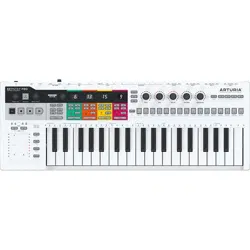Loading ...
Loading ...
Loading ...

5.3.5. Working with Patterns
5.3.5.1. Using the Main Encoders
When in Seq mode, the five main encoders can be used to edit the parameters of the current
track.
Gate
The Gate parameter is used to adjust the length (ON time) of a note. Possible values are
from 0.06 step (very short) to 64 steps (very long). These values can be set independently
for each step in a Pattern. By default, the Gate time is set to 0.5 step for each note.
Velocity
If a step in the Pattern is too loud or soft, you can edit its velocity using the Velocity
encoder. Just select the step in question by pressing the appropriate step button, then turn
the Velocity encoder to change its value to a new value in the range 0-127.
The default velocity is 100.
Time Shift
The Time Shift encoder can be used to shift the timing of steps backward or forward in
relation to the beat grid. This can help add a more 'human' feel to your patterns. The range
is -49 to +50, where 50 is half of the Time Division value.
Another remarkable option you have is to add a timing offset to individual notes stored in a
step! Just select a note or notes of the chord stored in that step and shift them forward or
backward in time with the Time Shift encoder. Why is this important?
When playing chords live, a musician will never press all the keys of the chord at the
same time; there will always be slight timing differences between the notes of a chord. One
musician will tend to strike a chord with the index finger first; another with the middle finger
first. You might call this the musician's 'signature'. Another use for this Time Shift feature is to
emulate strumming or finger-picking a guitar chord. Used in tandem with copying/pasting
steps as explained in the next paragraph, you can create very intricate sequences.
♪: Touch the Time Shift encoder to check the Time Shift value of a note.
Randomness
The Randomness encoder can be used to randomly mute note events in your sequence. In
other words, it can be used to create automatic variety in the sequence. Per step, you can
set the probability that it will play in the sequence. If you set different values for each step,
every repeat will be unique.
86 Arturia - User Manual Keystep Pro - Making Tracks
Loading ...
Loading ...
Loading ...
